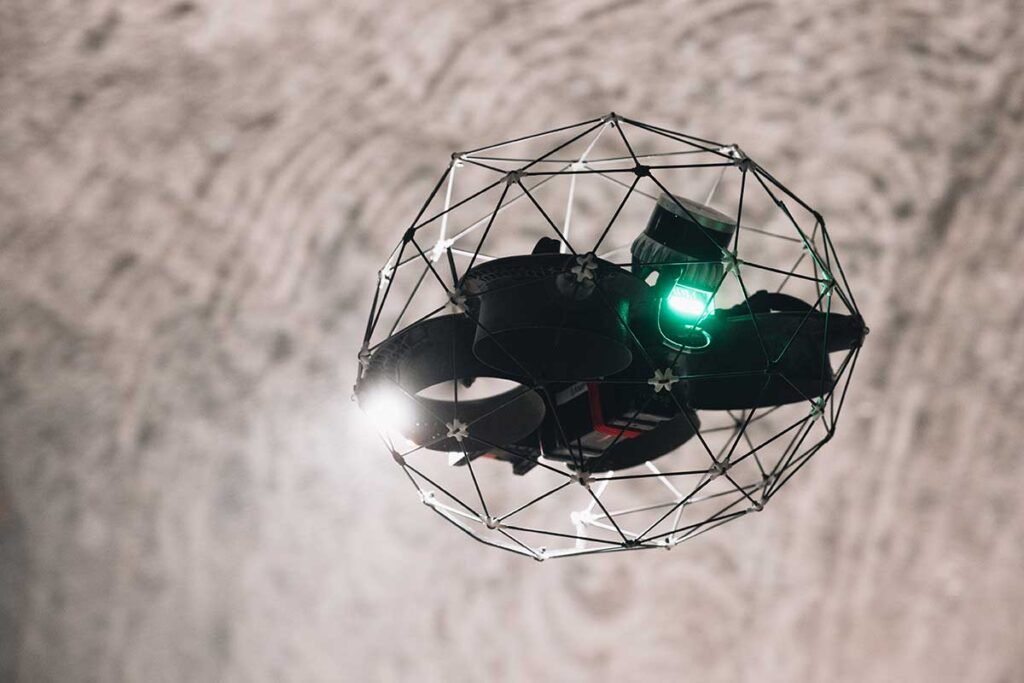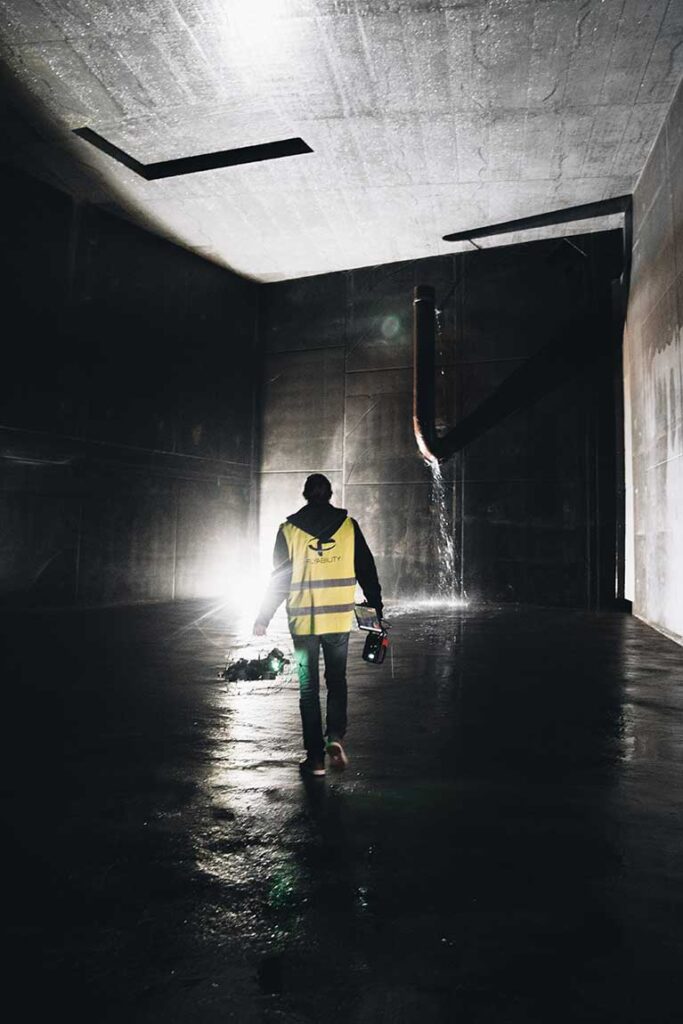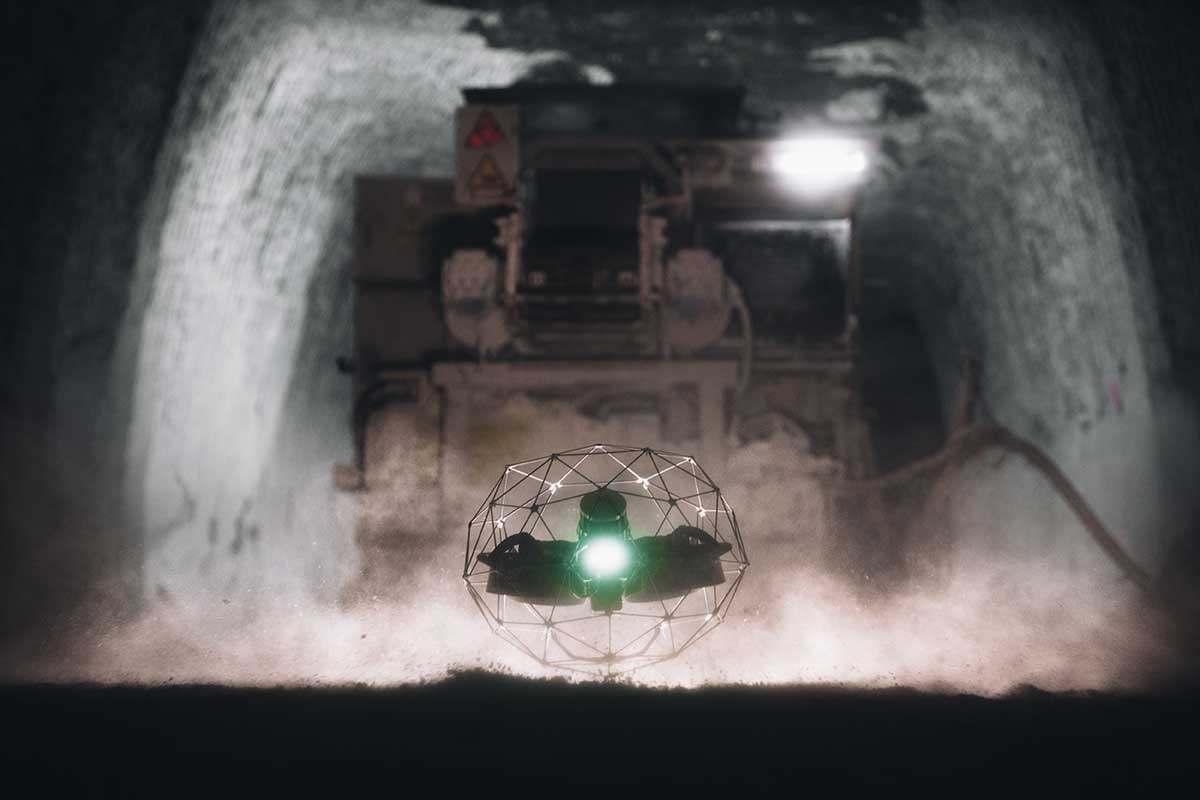Flyability, a Swiss company founded in 2014, has made significant strides in the drone industry by pioneering collision-tolerant drones designed for inspecting confined and inaccessible spaces in GPS-denied environments. The company’s flagship product, the Elios series drone, has been instrumental in vastly improving safety and efficiency across various sectors, particularly in the energy industry. However, in a recent Dawn of Autonomy podcast, Junio V. Palomba, Managing Director of Flyability Inc.,
discussed how this unique technology also holds immense potential for public safety applications, where safety and efficiency remains equally paramount.
The Origins…and The Pivot
Flyability, a Swiss company, was founded in 2014 by Patrick Thévoz and Adrien Briod. The idea for Flyability’s unique drones was inspired by nature, specifically how insects navigate through environments by using collisions to their advantage. This biomimicry approach led to the development of collision-tolerant drones designed for inspecting confined and inaccessible spaces.
As Palomba recounted, “Our CTO and co-founder Adrien was a PhD student at the PolyTechnical School of Lausanne (EPFL), which is the birthplace of Flyability. He was inspired by nature, specifically how fruit flies use collisions to navigate unknown environments. This led to building a cage around the drone, allowing it to withstand collisions.”
The first seed funding for Flyability came from winning a drone competition in Abu Dhabi, which provided the initial capital to develop their technology. While the founders initially envisioned applications in spelunking and emergency response, early investors saw potential in industrial inspections, which then became the company’s primary focus.
Today, Flyability has over 1,200 customers in 68 countries. Its Elios drone is currently in its third iteration, the aptly named Elios 3.

Evolution of the Elios Drone
The Elios drone series has undergone significant evolution since its inception. Palomba highlighted that customer feedback played a crucial role in shaping the product roadmap. As the product evolved, Flyability faced engineering challenges, such as accommodating different industry requirements. For instance, the mining sector was less concerned with the drone’s size, while the maritime sector requested smaller designs. This feedback, among others, influenced the development of subsequent models, including the current Elios 3, which features a modular design to accommodate various payloads.
Elios 1: Off to a Strong Start
The Elios 1, the first iteration of Flyability’s collision-tolerant drone, was a groundbreaking device when it emerged. The Elios 1 was equipped with an HD camera and integrated LED lighting, which allowed it to operate in low-light environments. It also featured a rotating cage with a double gimbal system.
While providing protection against collisions, this original design restricted visibility and made navigation more challenging. Its maneuverability and ability to fly inside confined areas were limited compared to later models.
Despite these limitations, this initial design marked the beginning of Flyability’s journey into industrial inspections, particularly in dangerous and hard-to-reach environments. The Elios 1 set the foundation for the development of the company’s later, more advanced drones.
Elios 2: Answering the Call
Based on customer feedback, the Elios 2 drone introduced several improvements over its predecessor. It featured enhanced camera quality in the form of crisp 4K images. This allowed for closer inspection of defects such as corrosion, pitting or missing bolts.
The design shift from the double gimbal system to a fixed cage provided similar collision resistance while offering an unrestricted central view. This made navigation and orientation much easier. This upgrade enabled users to zoom in and focus on visual defects more effectively, which enhanced the overall inspection experience.
Other improvements on the Elios 2 included its ability to plug-and-play a variety of new sensors. This capability was part of Flyability’s broader strategy to expand its inspection capabilities beyond visual checks and incorporate advanced payloads in the future.
Elios 3: A Substantial Leap Forward
Flyability’s latest model, the Elios 3, incorporates even more advanced features. It stands out due to its ability to operate in GPS-denied environments, using a combination of LiDAR and visual inertial odometry (VIO) cameras for navigation. Its cage design allows it to withstand collisions while custom firmware and a proprietary propulsion system helps it recover from impact, which provides an extra layer of safety for operators. The drone is also equipped with powerful lighting for inspecting in pitch-black environments. It also features modular payload ports to integrate various sensors, such as ultrasonic thickness monitors and radiation sensors. It comes with an onboard LiDAR for 3D mapping, which generates real-time 3D models of interior spaces and provides a comprehensive view of environments previously unattainable. This means that any data points captured during a flight are localized within the 3D model, making it easy to return to the same point for repeat inspections or pinpoint the exact location of a defect or fault for maintenance.
While Flyability may be best known for its unique drones, its software ecosystem remains a critical component underpinning its drone technology and enhancing the utility of the data collected.
The Powerful Software Ecosystem Behind the Drones
Flyability’s software ecosystem includes proprietary systems like FlyAware and Inspector 5, designed to optimize the inspection process from navigation to reporting.
FlyAware System
The FlyAware system is a navigation tool that enables the Elios drones to operate effectively in confined spaces. It combines data from LiDAR sensors and VIO cameras to provide real-time navigation and stability. This capability is also essential to create detailed 3D models of inspected environments, invaluable to assess structural integrity and plan maintenance or response strategies.
Inspector 5 Software
Inspector 5, Flyability’s advanced software for analyzing and reporting inspection data, allows users to organize data by asset and inspection and to create a digital twin of the inspected environment. This digital representation enables precise defect localization, data organization and seamless reporting. Inspector 5 streamlines workflows by automatically merging data into a single frame of reference to provide a comprehensive view of assets. Users can visualize points of interest in high-resolution 3D maps, analyze defects with precision tools and generate easily shareable professional reports.
Cloud-Based Solutions
Flyability’s software solutions are designed to work seamlessly with cloud-based platforms to allow for efficient data management and collaboration. The integration with Flyability Cloud enables users to upload inspection data, analyze it remotely and share findings across teams or with stakeholders. This cloud-based approach supports Flyability’s goal of providing holistic solutions that enhance safety, efficiency, and decision-making in various industries.
Integration with Partner Software
Flyability’s commitment to innovation and customer feedback has led to strategic partnerships that enhance its software ecosystem. For instance, the company’s collaboration with WinCan for sewer inspections integrates data from the Elios drones into WinCan’s Web solution. This allows for seamless analysis and reporting that meets industry standards.
Flyability’s purpose-built hardware and software designs have resulted in a winning combination for success in a wide range of industries. The energy sector, the company’s initial focus area, has risen to the top of that list.
Energy Sector Successes
Flyability originally focused its efforts on industrial inspections, particularly in the energy sector. The unique design of the family of Elios drones means they can access environments that were previously inaccessible or required extensive and costly safety protocols to reach. Projects that previously required hundreds of hours of scaffolding and inspection work can now be completed in less than a day – for example, condenser inspections cut from 8 days to 8 hours. Now, with the addition of custom sensors such as the radiation detection (RAD) or ultrasonic thickness gauge (UT), add to the Elios’s data collection offering, making it possible to inspect nuclear power plants, boilers, ship cargo tanks, chimneys, and other challenging but critical assets.
This capability has significantly reduced the risks associated with manual inspections, which often require costly and dangerous setups like scaffolding or rope access. By providing a safer, more efficient and cost-effective solution, Flyability quickly rose to become a leader in energy sector drones – with some energy providers developing fleets of Elios drones to support inspection operations at multiple sites, including nuclear power plants. Palomba noted that the return on investment (ROI) from the Elios drones universally justified this success.
“In order to perform even basic visual inspections, a nuclear plant operator would normally have to bring down the generator almost to a halt,” he said. “That would cost them millions of dollars in lost revenues.” The Elios drones can inspect without shutting down operations. This not only significantly reduces costs, it also improves safety by minimizing human exposure risks such as radiation.
“The concept of ALARA (As Low As Reasonably Achievable) exists in the nuclear power industry, in terms of radiation,” Palomba explained. “Once plant managers and experts got wind of our solution, it was Christmas for us!” Today, nearly 90% of U.S. nuclear power plants use their drones.”
While Flyability’s success in the energy sector is well-documented, their technology also offers substantial benefits for public safety applications.

The Benefits to Public Safety
The same features that make the Elios family of drones so effective in the energy sector directly bridge over to the public safety arena.
GPS-Denied Capabilities
For example, the Elios 3’s combination of LiDAR, VIO and thermal cameras, which allow for operation in GPS-denied environments, makes it particularly useful in confined spaces like tunnels or collapsed buildings. This capability is invaluable in disaster response situations where traditional navigation systems may fail.
The company’s software backbone, which complements its drone technology to offer a comprehensive solution for inspection and analysis, further makes it ideal for public safety. Palomba noted that the FlyAware system, a key part of the drone’s ability to navigate GPS-denied environments, equally applies in public safety applications where quick and accurate assessments are crucial. One such example includes investigating a collapsed tunnel in the Swiss Alps after a landslide.
Software Integrations
Palomba also highlighted the company’s focus on software integration, such as its partnership with WinCan, as illustrative of the potential for similar integrations in public safety contexts, where standardized reporting and analysis remain critical to effective response strategies. These partner software integrations, combined with the company’s cloud-based solutions, enable Flyability to continue expanding its offerings across diverse sectors, including public safety.
Already Tried and True
As mentioned above, Flyability’s origins trace back to a desire to assist in emergency response. Although the company’s mark has been made in energy, the Elios drones’ versatility is just as crucial in public safety scenarios where quick, safe and accurate assessments are also essential.
In fact, its dual-use classified drones have already been used in emergency response situations, from building collapses to gas leaks, where sending personnel would have been dangerous. For instance, in a recent incident in Johannesburg, the Elios 3 was used to assess damage after a gas leak caused an explosion. It provided critical information without risking human lives.
Palomba elaborated on the versatility of the Elios 3 in this and other public safety scenarios. “The Elios 3 has some of the very best stabilization in the world, a modular payload system, the ability to create 3D models in real-time while in flight, and it paves the way towards an increasingly autonomous future,” he said. This capability to adapt to new environments and tasks positions Flyability’s technology as a critical tool for enhancing public safety operations.
Palomba continued, “We’ve recognized over time that there are situations in which the Elios platforms can have a positive impact for public safety… It’s probably not the most advertised of our segments because of the nature of the work that is performed with the drone in these kinds of situations.”
In short, the Elios drones’ ability to navigate GPS-denied environments and provide detailed 3D maps and modular design which allows for the integration of various payloads, makes it highly adaptable to different public safety applications.
Future Directions
Flyability’s trek from a startup to a leading player in indoor drone technology is a testament to its adaptability. As the company continues to expand its presence in the public safety sector, the company stands ready to leverage its expertise in confined space inspections to address emerging challenges.
With ongoing investments in autonomy and payload development, the Elios drones will likely become even more versatile and offer enhanced capabilities for a broader range of applications.
Flyability’s growth is also reflected in its expanding team and operations. The company is actively hiring in its Denver office. This not only signals a strong commitment to the U.S. market, it also teases further development of its technology.
By now successfully bridging the gap between the energy and public safety sectors, Flyability continues to demonstrate the potential of its drone technology to enhance safety and efficiency across a wide variety of industries. Keep an eye on this company as it continues to evolve and expand its offerings to enhance industrial and organizational safety worldwide.
By: Dawn Zoldi

